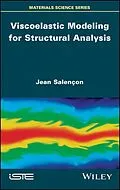The theory of viscoelasticity has been built up as a mechanical framework for modeling important aspects of the delayed behavior of a wide range of materials. This book, primarily intended for civil and mechanical engineering students, is devoted specifically to linear viscoelastic behavior within the small perturbation framework. The fundamental concepts of viscoelastic behavior are first presented from the phenomenological viewpoint of the basic creep and relaxation tests within the simple one-dimensional framework. The linearity and non-ageing hypotheses are introduced successively, with the corresponding expressions of the constitutive law in the form of Boltzmann's integral operators and Riemann's convolution products respectively. Applications to simple quasi-static processes underline the dramatic and potentially catastrophic consequences of not taking viscoelastic delayed behavior properly into account at the design stage. Within the three-dimensional continuum framework, the linear viscoelastic constitutive equation is written using compact mathematical notations and takes material symmetries into account. The general analysis of quasi-static linear viscoelastic processes enhances similarities with, and differences from, their elastic counterparts. Simple typical case studies illustrate the importance of an in-depth physical understanding of the problem at hand prior to its mathematical analysis.
Autorentext
Jean Salençon is a Member of the French Academy of Sciences, the French Academy of Technologies, and Academia Europaea. He is also an Honorary/Foreign Member of the Academies of Hungary, Milan and Lisbon. Senior Fellow of the Hong Kong Institute for Advanced Study (HKIAS), his research interests include continuum mechanics, structural analysis and soil mechanics.
Inhalt
Preface ix
List of Notations xiii
Chapter 1. One-dimensional Viscoelastic Modeling 1
1.1. Experimental observations 1
1.2. Fundamental uniaxial tests 2
1.2.1. Creep test, creep function 2
1.2.2. Stress relaxation test, relaxation function 5
1.2.3. First comments 7
1.2.4. Recovery 8
1.2.5. Stress fading 9
1.3. Functional description 10
1.4. Aging 11
1.4.1. Aging phenomenon 11
1.4.2. Non-aging materials 12
1.5. Linear behavior 14
1.5.1. Superposition principle: Boltzmannian materials 14
1.5.2. Linear elasticity 15
1.6. Linear viscoelastic material 15
1.6.1. Instantaneous behavior 16
1.6.2. Creep and relaxation functions 16
1.6.3. Recovery and stress fading 18
1.6.4. Instantaneous behavior 19
1.6.5. Validation of the linearity hypothesis: An example 19
1.7. Linear viscoelastic constitutive equation 20
1.7.1. Arbitrary stress history 20
1.7.2. Arbitrary deformation history 23
1.7.3. Linear elastic material 24
1.7.4. Boltzmann's formulas, integral operator 24
1.7.5. Comments 26
1.8. Non-aging linear viscoelastic constitutive equation 27
1.8.1. Creep and relaxation functions 27
1.8.2. Boltzmann's formulas 28
1.8.3. Recovery and stress fading 30
1.8.4. Operational calculus 30
1.9. One-dimensional linear viscoelastic behavior 33
1.9.1. Uniaxial viewpoint and one-dimensional modeling 33
1.9.2. Structural elements 36
1.10. Harmonic loading process 39
1.10.1. The loading process 39
1.10.2. Asymptotic harmonic regime 40
1.10.3. Complex modulus 41
1.10.4. Loss angle, specific loss 43
Chapter 2. Rheological Models 45
2.1. Rheological models 45
2.2. Basic elements 45
2.2.1. Linear elastic element 45
2.2.2. Linear viscous element 46
2.3. Classical models 47
2.3.1. Maxwell model 47
2.3.2. Kelvin model 49
2.3.3. The standard linear solid 51
2.4. Generalized Maxwell and Kelvin models 56
2.4.1. Generalized Maxwell model 57
2.4.2. Generalized Kelvin model 58
2.4.3. Equivalence 59
2.4.4. Continuous spectra 60
Chapter 3. Typical Case Studies 63
3.1. Presentation and general features 63
3.2. Creep-type problems 64
3.2.1. Homogeneous cantilever beam subjected to a uniformly distributed load 64
3.2.2. Homogeneous cantilever beam subjected to a concentrated load 68
3.2.3. Homogeneous statically indeterminate beam 70
3.2.4. A statically indeterminate system 72
3.3. Prestressing of viscoelastic systems or structures 75
3.3.1. Prestressed cantilever beam 75
3.3.2. Prestressed hyperstatic system 79
3.3.3. Prestressed hyperstatic arc 80
3.3.4. The example of a rheological model 84
3.3.5. Practical applications 88
3.4. A complex loading process 93
3.4.1. A practical problem 93
3.4.2. Mathematical treatment 95
3.4.3. Comments 97
3.5. Heterogeneous viscoelastic structures 98
Chapter 4. Three-dimensional Linear Viscoelastic Modeling 103
4.1. Multidimensional approach 103
4.2. Fundamental experiments 104
4.2.1. The three-dimensional continuum framework 104
4.2.2. General definition of the creep and relaxation tests 105
4.2.3. The linearity hypothesis. 105
4.2.4. Tensorial creep and relaxation functions 106
4.2.5. Instantaneous elasticity 107
4.3. Boltzmann's formulas 108
4.3.1. Integral operator 108
4.3.2. Important identities 109
4.4. Isotropic linear viscoelastic material 110
...
